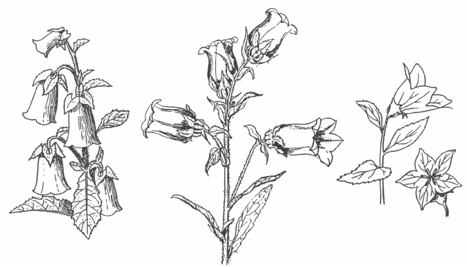Family Description
The bellflower family is a group of dicotyledonous herbs (rarely shrubs or trees) widely distributed in temperate and tropical regions. There are 40 genera with 700 species in the family. The sap of many species is milky. Leaves are alternate, without stipules, and usually simple. Flowers are solitary, or more commonly in spikes or panicles. Flowers are symmetrical, 5-merous, with the corolla usually campanulate and in shades of blue or purple (rarely white). The fruit is a many-seeded capsule.
-
The key diagnostic features are:
- alternate, simple leaves
- blue or purple campanulate flowers
Bellflowers are easily grown in sunny, cool sites with good drainage. Plants are long lived once established. Propagation is by division, cuttings or seed. Seeds germinate easily with 70°F best for rapid germination. Pests are not serious.
Important genera in this family include: Adenophora, Campanula, Canarina, Codonopsis, Cyananthus, Edraianthus, Jasione, Legousia, Mindium, Ostrowski, Phyteuma, Platycodon, Symphyandra, Trachelium, Triodanis, and Wahlenbergia.

Symphyandra armeria (left) Campanula medium (center) and Platycodon grandiflora (right).
Representative Species
click thumbnail to enlarge |
|||||||
| * | Campanula spp | Bellflower |
|
||||
| Platycodon grandiflorus | Balloon Flower |
|

